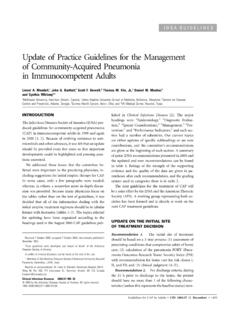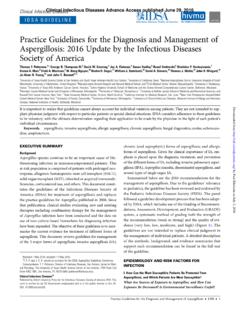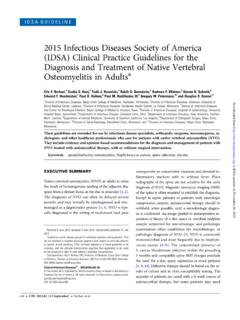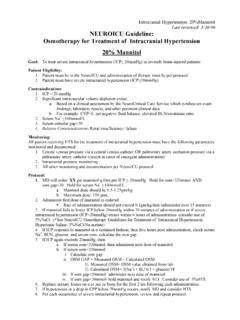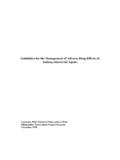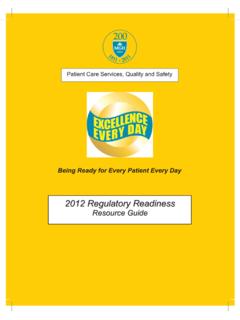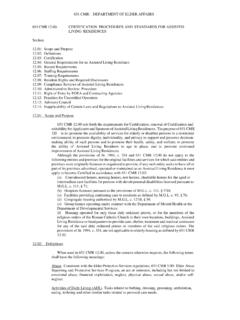Transcription of 2017 Infectious Diseases Society of America Clinical ...
1 Clinical Infectious Diseases CID 2017:XX (XX XXXX) 12017 IDSA Guidelines for the Diagnosis and Management of Infectious DiarrheaClinical Infectious Diseases 2017;XX(00):1 362017 Infectious Diseases Society of America Clinical Practice Guidelines for the Diagnosis and Management of Infectious DiarrheaAndi L. Shane, MD1 Rajal K. Mody, MD2 John A. Crump, MD3 Phillip I. Tarr,4 Theodore S. Steiner, MD5 Karen Kotloff, MD6 Joanne M. Langley, MD7 Christine Wanke, MD8 Cirle Alcantara Warren, MD9 Allen C. Cheng, PhD10 Joseph Cantey, MD11 and Larry K.
2 Pickering, MD121 Division of Infectious Diseases , Department of Pediatrics, Emory University and Children s Healthcare of Atlanta, Atlanta, Georgia; 2 Division of Foodborne, Waterborne, and Environmental Diseases , Centers for Disease Control and Prevention, Atlanta, Georgia; 3 Division of Infectious Diseases and International Health, Duke University Medical Center, Durham, North Carolina; Centre for International Health, University of Otago, Dunedin, New Zealand; 4 Division of Gastroenterology, Hepatology, and Nutrition, Washington University in St. Louis School of Medicine, St.
3 Louis, MO; 5 Nutrition, Washington University in St. Louis School of Medicine, St. Louis, MO; 5 Division of Infectious Diseases , University of British Columbia, Vancouver, BC, Canada; 6 Division of Infectious Disease and Tropical Pediatrics, Department of Pediatrics, and the Center for Vaccine Development, University of Maryland School of Medicine, Baltimore, MD; 7 Department of Pediatrics, Dalhousie University, Halifax, NS; 8 Division of Nutrition and Infection, Tufts University, Boston, Massachusetts,Cirle Alcantara Warren, MD; 9 Division of Infectious Diseases and International Health, University of Virginia, Charlottesville, Virginia; 10 School of Public Health and Preventive Medicine, Monash University, Melbourne, Australia, 11 Division of Infectious Diseases , Department of Medicine, Medical University of South Carolina, Charleston, South Carolina.
4 And 12 Division of Infectious Diseases , Department of Pediatrics, Emory University, Atlanta, GeorgiaThese guidelines are intended for use by healthcare professionals who care for children and adults with suspected or confirmed Infectious diarrhea. They are not intended to replace physician judgement regarding specific patients or Clinical or public health situ-ations. This document does not provide detailed recommendations on infection prevention and control aspects related to Infectious diarrhea; Infectious ; diagnostics; management; prevention.
5 EXECUTIVE SUMMARYThe following evidence-based guidelines for management of infants, children, adolescents, and adults in the United States with acute or persistent Infectious diarrhea were prepared by an expert panel assembled by the Infectious Diseases Society of America (IDSA) and replace guidelines published in 2001 [1]. Public health aspects of diarrhea associated with foodborne and waterborne diarrhea, international travel, antimicrobial agents, immunocompromised hosts, animal exposure, certain sexual practices, healthcare-associated diarrheal infections, and infections acquired in childcare and long-term care facil-ities will be referred to in these guidelines, but are not cov-ered extensively due to availability of detailed discussions of this information in other publications.
6 For recommendations pertaining to Clostridium difficile, refer to the existing IDSA/ Society for Healthcare Epidemiology of America (SHEA) guidelines on C. difficile infections, which are in the process of being below are recommendations made in the updated guidelines for diagnosis and management of Infectious diarrhea. The Panel followed a process used in development of other IDSA guidelines [2] which included a systematic weight-ing of the strength of recommendation and quality of evidence using GRADE (Grading of Recommendations Assessment, Development and Evaluation) [3 7].
7 A detailed description of the methods, background, and evidence summaries that support each of the recommendations can be found online in the full text of the FOR THE DIAGNOSIS AND MANAGEMENT OF Infectious DIARRHEAC linical, Demographic, and Epidemiologic FeaturesI. In people with diarrhea, which Clinical , demographic, or epidemio-logic features have diagnostic or management implications? (Tables 1 3) A detailed Clinical and exposure history should be obtained from people with diarrhea, under any circum-stances, including when there is a history of similar illness in others (strong, moderate).
8 2. People with diarrhea who attend or work in child care centers, long-term care facilities, patient care, food service, or recreational water venues (eg, pools and lakes) should follow jurisdictional recommendations for outbreak reporting and infection control (strong, high).IDSA GUIDELINEXXXXXX The Author 2017. Published by Oxford University Press for the Infectious Diseases Society of America . All rights reserved. For permissions, e-mail: 17 July 2017; editorial decision 19 July 2017; accepted 26 July : A. L. Shane, MD, MPH, MSc, Associate Professor of Pediatrics and Interim Clinical Division Chief, Division of Pediatric Infectious Disease, Marcus Professor of Hospital Epidemiology and Infection Control, Emory University School of Medicine and Children s Healthcare of Atlanta, 2015 Uppergate Drive NE, Rm.
9 504A, Atlanta, GA 30322. from University of Pennsylvania Libraries useron 20 October 20172 CID 2017:XX (XX XXXX) Shane etThalII. In people with fever or bloody diarrhea, which Clinical , demo-graphic, or epidemiologic features have diagnostic or management implications? (Tables 1 3) People with fever or bloody diarrhea should be evaluated for enteropathogens for which antimicrobial agents may confer Clinical benefit, including Salmonella enterica sub-species, Shigella, and Campylobacter (strong, low).4. Enteric fever should be considered when a febrile person (with or without diarrhea) has a history of travel to areas in which causative agents are endemic, has had consumed foods prepared by people with recent endemic exposure, or has laboratory exposure to Salmonella enterica subspecies enter-ica serovar Typhi and Salmonella enterica subspecies enter-ica serovar Paratyphi (strong, moderate).
10 In this document, Salmonella Typhi represents the more formal and detailed name Salmonella enterica subspecies enterica serovar Typhi, and Salmonella Paratyphi corresponds to the Paratyphi What Clinical , demographic, or epidemiologic features are asso-ciated with complications or severe disease? (Tables 2 and 3) 1. Modes of Acquisition of Enteric Organisms and Sources of GuidelinesModeTitleURLA uthor/Issuing AgencyInternational travelExpert Review of the Evidence Base for Prevention of Travelers et al [113]Medical Considerations Before International et al [207]
